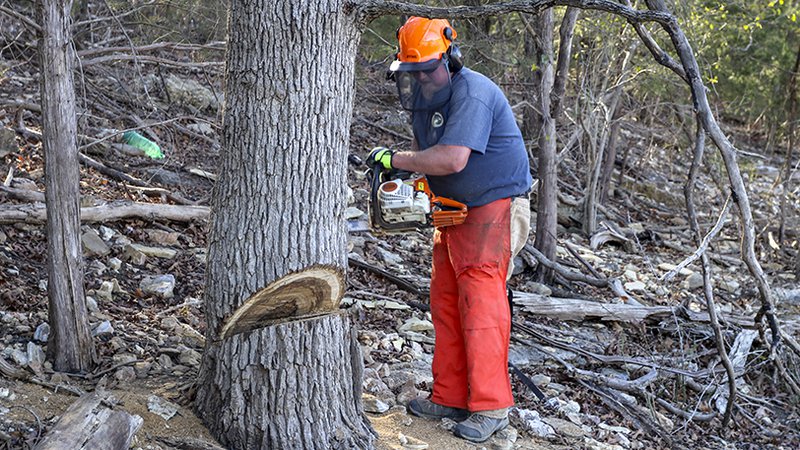Create essential wildlife habitat with firewood
ON 01-30-2019

Jan. 30, 2019
Randy Zellers
Assistant Chief of Communications
LITTLE ROCK – For landowners who enjoy a nice fire in their hearth or woodstove, the best time of year to cut next winter’s supply of wood is during late winter. With a little extra thought to the resulting woodlands, this can also be a great time to add valuable wildlife habitat on the ground.
Cutting trees for firewood is best done while the trees are dormant; the sap is concentrated in the roots, leaving the stem at its lowest moisture point of the year. Late winter cutting also allows an ideal amount of time for the firewood to season properly for the next winter.
Choosing a few mature oaks and hickories to remove from the forest canopy not only offers excellent, high-heat-value firewood, but also allows sunlight to penetrate to the forest floor, spurring new growth.
According to Marcus Asher, quail program coordinator for the Arkansas Game and Fish Commission, landowners should strive to allow at least 50 percent sunlight through to the forest floor to stimulate native grasses and ground cover for ground-nesting birds, such as northern bobwhite and wild turkeys. The new growth close to the ground also benefits many other wildlife species, such as deer, that will feed on the fresh browse at ground level throughout spring and summer when acorns and other hard mast have been eaten or rotted.
Thinning the forest canopy also can create better growing conditions for the trees remaining in the stand.
“Timber stand improvement can be used to ‘weed’ your forest similar to a garden,” Asher said. “Undesirable species such as hickory, elm, locust, hackberry, and cedar can be removed to give oaks more room to grow and produce more acorns.”
A stand of oaks with closely spaced trunks may look healthy, but those trees are constantly competing for the same water, nutrients and sunlight. Removing some trees near your best producers will enable them to spread their branches and create even more hard mast in years to come.
Cut cedars, sweetgums and other less desirable firewood species can be used to create brush piles on the property, which will provide valuable escape cover and bedding cover for many wildlife species, including ground-nesting birds, deer and rabbits. An adequately-sized brush pile should be around 1500 square feet and piling of tops and trunk should not be tight like you are going to burn it; instead it should be loosely placed to allow maneuverability of small game throughout the inside of the pile.
“Man-made brush piles should be scattered throughout a field,” Asher said. “We always use the analogy of ‘softball-throwing distance,’ roughly 200 feet, between brush piles and cover. This gives quail, rabbits and other small species places to run to instead of being cornered in a single spot.”
Combined with other practices, such as fall tilling, prescribed fire and encouraging native grasses over sod-forming exotic species, properly planned thinning of forests can greatly improve the value of land for a host of wildlife species.
Recent News

Arkansas Wildlife Weekly Fishing Report
Jul. 10, 2025

Lonoke aquaculturist named to AGFC
Jul. 10, 2025
Subscribe to Our Weekly Newsletter E-mails
Don’t miss another issue. Sign up now to receive the AGFC Wildlife Weekly Newsletter in your mailbox every Wednesday afternoon (Waterfowl Reports are published weekly during waterfowl season and periodically outside the season). Fishing Reports arrive on Thursdays. Fill in the following fields and hit submit. Thanks, and welcome!
